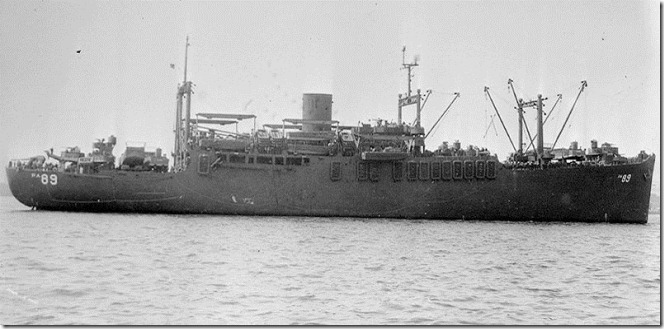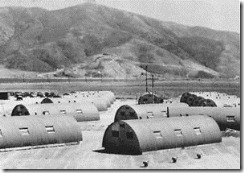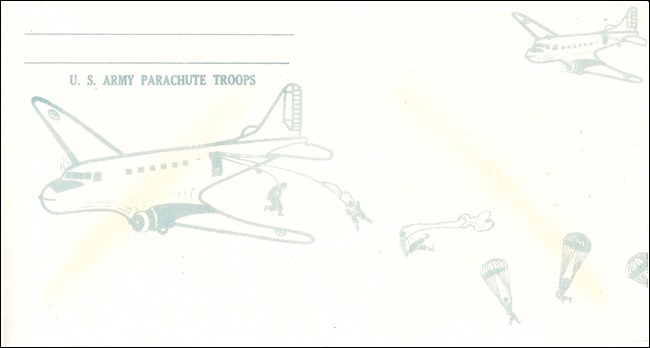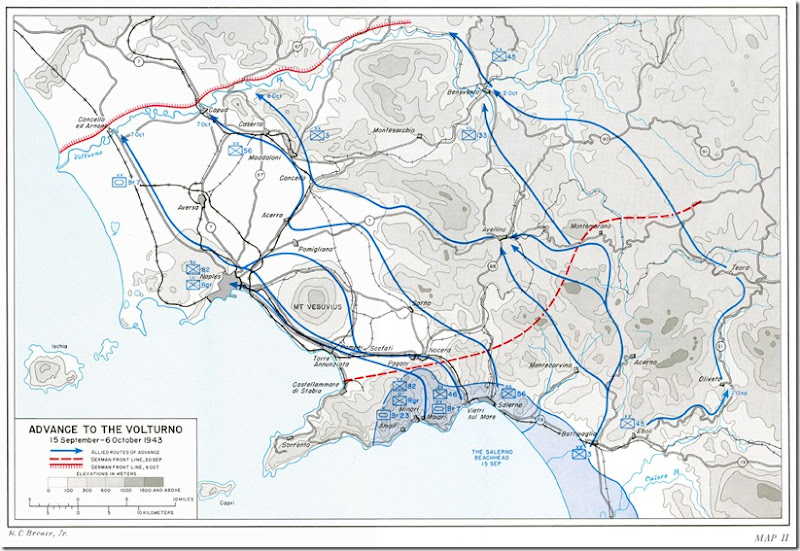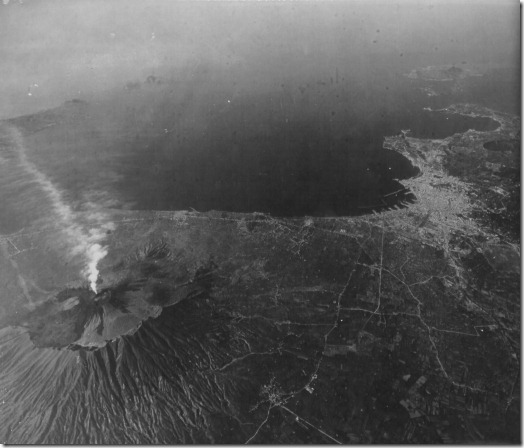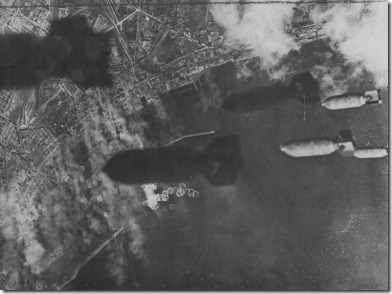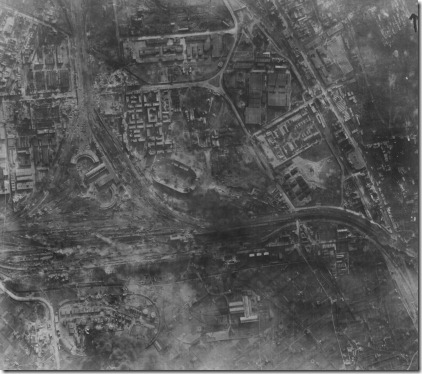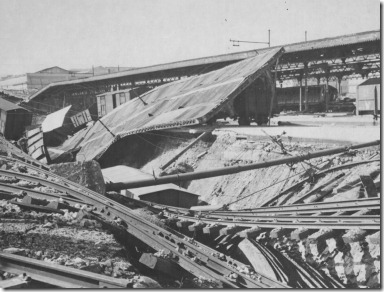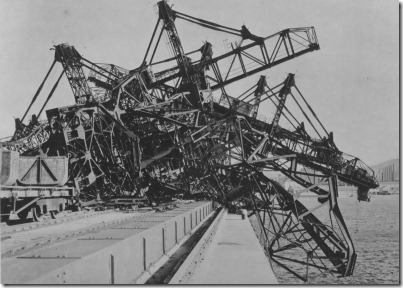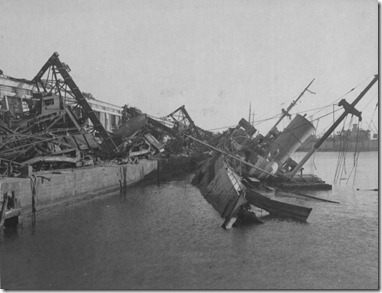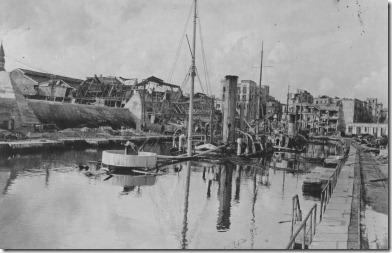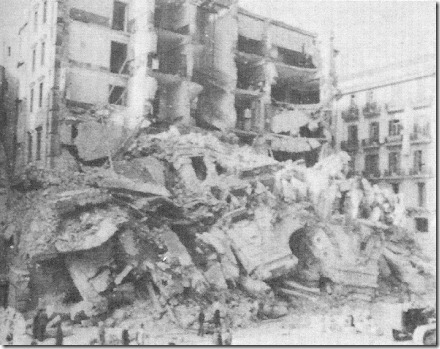Leaving Naples
On November 18, 1943, the 505 PIR boarded the USAT (US Attack Transport) Frederick Funston, an attack troop transport vessel which had already seen service in WWII during the Sicily and Salerno campaigns. The destination was unknown to Bill or anyone else at his rank. He said they sailed west to the port of Oran, Algeria to pick up supplies. The men got some shore leave. They celebrated Thanksgiving with a turkey dinner.
Bill said they were in port for about a week before they got underway again. They were part of a convoy of protective destroyers and trooper transport ships carrying the rest of the 82nd Airborne Division deployed in the Mediterranean, except for the 504 PIR and other units including company of 307th Combat Engineers, which had been left behind in Italy at the request of General Mark Clark.
(Date of photo unknown)
Source: Wikipedia
Bill said they headed west across the Mediterranean Sea, passing through the Straights of Gibraltar:
“The boat headed west out into the Atlantic, and we said ‘ look at that compass pointing dead west.’ We were sure we were headed home. But it turned out just to be a diversion to avoid Nazi submarines”. Suddenly on our western course we saw the compass turn to the northeast and we said , ‘Oh no!’. The ship was headed for Belfast, Ireland”. Source: Interview with William Clark by Herd Bennett, January 26, 2000
Conditions on board were much the same as the voyage to Casablanca on the George Washington, in April – May, 1943 with cramped, humid conditions, fetid air, movies, religious services, and gambling.
Arrival in Northern Ireland
On December 9, 1943, the USAT Frederick Funston made anchor in the port of Belfast. The 325th Glider Infantry Regiment (GIR) came in on the same day aboard the USNS (US Naval Service) James O’Hara. Other vessels were with the convoy carrying various smaller units of the 82nd. Bill said that as his boat entered the harbor, looking over the bow, he could see divers swimming ahead of the ship. They were making sure the ship’s path was cleared of mines possibly planted by Nazi U-boats.
(Click on the lines and blue place markers for more information)
These newly trained 507th and 508th PIRs were to arrive from the US separately and later to join with the other two large airborne units – the seasoned 505 PIR and 325 GIR. The 508 arrived on December 5, 1943, aboard the HMS Strathnaver, while the 508 arrived on January 9, 1944 on the USAT James Parker.
Right from the start, when the men stepped off their ships onto the docks in Belfast harbor, they couldn’t believe their turn in fortune. The streets were clean; the buildings in good repair. There were no thieves or beggars to be wary of; no North African dust storms; no flies (and the dysentery that came with them); no malaria nor typhus, and no blazing heat. The people spoke English and the girls were beautiful. The locals were the first English speaking civilians they had seen since leaving New York harbor almost eight months previously. In many ways it must have seemed like being in army training in America, but with cultural and geographical curiosities which made it intriguing and exciting in the way a tourist feels about visiting a friendly foreign land.
They were trucked or trained to their new billets in a variety of places across the counties of Tyrone, Londonderry, and Antrim. For the 505 and the other 82nd Airborne units arriving from the Mediterranean such as the 325th GIR, the green of Ireland was a sharp contrast to the barren, diseased, and hellish conditions of their training in North Africa. They drank it all in with alacrity; reveling in this unexpected heavenly paradise. To a degree, they even liked their housing which consisted of British Nissen huts and American Quonset huts; another welcome change from the tents of North Africa.
British Nissen huts were originally designed by an American, who later became a British citizen and WWI soldier engineer, Major Peter Norman Nissen. Source: “Inventing the 20th Century: 100 Inventions That Shaped the World”. Dulken, S., 2002, p. 44.
They were allegedly inspired by the Native American Iroquois Longhouses. Quonset huts were the American variant built before and during WWII and named after their place of design, Quonset Point, at the Davisville Naval Construction Battalion stationed in Davisville, Rhode Island. Source: “Quonset Huts” Retrieved from Waymaking.com Author unknown.
They can be found all over the WWII Allied world and are instantly recognizable by semi circular “aircraft hanger” like appearance. The inside of the huts were an open space which, by intention, could be converted into hospital wards, headquarters office space, or troop barracks.
Source: Wikipedia Commons
82nd Airborne Unit Camp Locations
The 82nd Airborne Division Headquarters were located around Castledawson, County Londonderry. See MAP 2 below for where they were quartered.
(Click on the lines and blue place markers for more information)
Bill’s Location in Northern Ireland
As with many episodes of Bill’s service with the 82nd Airborne, his stay in Northern Ireland is somewhat irregular with respect to the movements of his unit, his service record, and his own testimony during and after the war. The reasons for these discrepancies I believe have to do with his role as a parachute rigger in the 505 Service Company. As I’ve mentioned in previous posts, unlike other members of the 505 service company, riggers were required to jump into combat on a rotation basis with combat companies as a demonstration of the quality of their parachute maintenance, repair and packing. Much about the parachute riggers of WWII is not well documented – at least in published sources.
I very recently found one source which helps elucidate the role, work and movements of the 82nd Airborne riggers. The work is entitled “82nd Airborne Division: 82nd Parachute Maintenance Company”. The author is unknown, but it is an officially written document obtained at the 82nd Airborne Museum, Fort Bragg, North Carolina. Curiously, even with this source there are discrepancies between it, on the one hand, and Bill’s testimony after the war, letters he wrote home and his service record, on the other hand. I’ll write more about these in later posts. Suffice it to say that as per his service record and testimony, Bill was often to be found with the 505 PIR fighting in combat zones when the riggers of the 82nd Airborne (which would have included him) were in the rear echelons maintaining parachutes. These discrepancies continue to be a confounding mystery, which I hope one day to resolve.
Whatever the case, Bill must have been a good rigger. In one of his interviews in 2000 with his friend and lawyer, Herd L. Bennett, he said that while in Naples, he was promoted to the rank of Technical Sergeant 4th Grade (T/4). Source: Interview with William Clark by Herd Bennett, January 26, 2000
Part of his new T/4 duties entailed leading a squad of riggers in repairing and packing parachutes.
Despite the fact that the 505 PIR was stationed in Cookstown, Bill stated that in Northern Ireland, he was stationed very near the town of Ballymoney in County Antrim. Source: Interview with William Clark by Herd Bennett, January 26, 2000
Ballymoney is 32 miles away from Cookstown, where the rest of the 505 PIR was camped. I have interviewed two other members of Bill’s unit, the Service Company 505; Privates John Snyder and Maurice Herron, and both of them confirmed that the Service Company riggers were always stationed away from them. However, if Bill was stationed near Ballymoney, 32 miles is extremely far away.
Parachute rigging and repair installations were built in Northern Ireland before the 82nd Airborne arrived. At least one such installation or “plant” has been described (see blue place marker at top of MAP 2 above).
In his engrossing and well researched book, “Passing Through: The 82nd Airborne Division in Northern Ireland 1943-44”, John McCann wrote of these parachute maintenance plants:
“At Ballyscullion, a small 315-acre townland on the outskirts of the south Derry Village of Bellaghy, preparations were already underway to facilitate the needs of the 82nd. On 27 November ‘Charlie’ Company, 202nd Engineer Combat Battalion arrived to begin the construction of a parachute drying, servicing and repacking plant. Each plant consisted of seven semi-circular steel framework buildings set on a concrete floor and covered in corrugated iron. Internally, fitted wooden boards provided adequate insulation for the overhead hot water heating system”. Source: “Passing Through: The 82nd Airborne Division in Northern Ireland 1943-44”, 2005 p. 46
Notice McCann states that “each plant consisted…” implying that there was more than one of these plants in Northern Ireland. He briefly mentions on page 61 that another was at built at Monrush in Cookstown, ironically where the 505 PIR were stationed (see blue place marker on top of MAP 3 above).
According to the unpublished, manuscript on the history of the 82nd Parachute Maintenance Company obtained from the 82nd Airborne Museum, there was another parachute maintenance installation. On page 8 the document states:
“The 505 combat team maintenance section, after being on the high seas for nearly a month, during which they ate Thanksgiving dinner (once thinking they were close to the USA) docked at Belfast, Ireland on the 9th of December, 1943. Moving on the village called Ballymoney they set up a packing shed on Millickore Airdrone [sic]. They worked day and night opening boxes and drying chutes. The men really enjoyed being in an English speaking country again, brogue [Irish accent] not considered, and had a very good time there.
After things settled down they could indulge in good beer and some potent Irish whiskey, not to mention the company of many local Irish coleens [Irish women]. On the day they finally started packing parachutes, they received orders to box up again, before 50 chutes had been packed, and be ready to move.” Source: “82nd Airborne Division: 82nd Parachute Maintenance Company”. Author unknown. Date unknown., p. 8
Bill’s whereabouts is difficult to ascertain for sure since the morning reports and muster calls for his unit and many others are missing from September 1943 onwards. They were destroyed in the 1973 fire at the National Personnel records center in St. Louis, Missouri.
However, given Bill’s testimony and this newly discovered information, it is certain that he was assigned to work at the parachute packing and repair installation located at Millickore Airdrome near Ballymoney in County Antrim. It makes sense that Bill would have been quartered near to a parachute maintenance installation.
According to John McCann, despite plans for parachute training, there were few airfields and no C-47s. The absence of these meant no parachute drops. Soon the planners realized that the parachute maintenance installations weren’t needed. Source: “Passing Through: The 82nd Airborne Division in Northern Ireland 1943-44”, 2005 p. 61
I have been unable to ascertain the exact area around Ballymoney where the Millickore Airdrome was located in WWII; where the 505 PIR riggers built their parachute maintenance shed and were likely billeted. It isn’t listed on well researched credible websites like:
“The Second World War in Northern Ireland” (http://ww2ni.webs.com/)
“Airfields of Country Antrim” page (http://ww2ni.webs.com/countyantrimairfields.htm)
Abandoned & Little-Known Airfields: United Kingdom, Northern Ireland Antrim(http://www.ronaldv.nl/abandoned/airfields/GB/N-Ireland/antrim.html)
To demonstrate what the airdrome and sheds may have looked like from the air as well as the likely distance from the airdrome and Ballymoney, the modern day “Causeway Airfield” (even though it is in County Londonderry) is used as a placeholder while I chase down this latest mystery.
The Causeway Airfield is indicated by the blue shape in the left of MAP 4 above. The blue line is the route from the airfield (where they would likely have been billeted) to the nearby large town of Ballymoney, three miles away, a place where the men would go when off duty.
Without sufficient airfields for parachute drops, opportunities for training the 82nd paratroopers was further limited because most of the area was used for growing crops. The only training options available were: road marches, some weapons training on firing ranges, obstacle courses, guard duty, parades, and patrols. Reveille was at 6:00 AM and lights out at 10:00 PM. At least in the case of the 505 PIR stationed in Cookstown, except for passes, men were limited to staying at camp. They played cards, gambled, read, and wrote letters.
Despite having said this, it appears that once drying of the chutes was underway i.e. “after things settled down”, the 505 riggers stationed at their billets near Ballymoney had time to enjoy their new (and in comparison to North Africa and even Naples) vastly improved surroundings.
With the 82nd Division Headquarters at Castledawson some 20 miles away and the 505 Regimental Headquarters even further distant at 32 miles, all indications are that this must have been a relatively easy assignment (see MAP 5 below). In comparison to their 505 brethren, the 505 riggers seem to have had more spare time and more freedom.
When Bill spoke to me of Northern Ireland during a visit in 1996, he excitedly told me of how naturally beautiful Ireland was. He said that during the war he had been stationed near the coast. He said he especially loved the coast line and remarked on how green the grass was. He marveled at how it grew all the way to the edges of the cliffs and that the contrast between the green grass and the deep blue of the sea was dazzling. He asked me if I had ever been there. I informed him that I hadn’t. He insisted that I should go one day because, in his opinion, Ireland really was a beautiful place.
In a letter home he wrote:
“I saw a lot of the British Iles. Ireland, England and Scotland. My opinion is that Ireland is the best of all”. Source: Letter dated January 14, 1945. William A. Clark, p. 2.
Ballymoney is only about 10 miles from the coast which would have made it quite easy for Bill and the 505 riggers to ride bicycles (a common mode of transport), or even walk there (See MAP 6 below). The coast in this area, known as the “Causeway Coast”, is quite picturesque. His unit’s close proximity to it would explain his fond recollections of Ireland’s breathtaking seaside.
Most of the other enlisted men of the 505 didn’t get to see the coast much because they were too far inland. They just didn’t have transportation to go anywhere. When issued passes, some moved around using public transportation such as buses, or trains and the like. Others used bicycles or walked. Some only were issued passes to Cookstown. Those more fortunate usually took their leave in large towns such as Belfast or Londonderry. The Service Company of each regiment was charged with driving troops from one place to another, so they could use their Regiment’s vehicles to get out more often even if it was only to move supplies or pick up and drop off troops for training.
Men of other 82nd Airborne units, namely the 507 PIR and 508 PIR, did see a lot of the coast. They were stationed on the Causeway Coast at Portrush (507 PIR) and Portstewart (508 PIR). (See the blue place markers on MAP 6 above). The men of these regiments gave similar descriptions to those Bill recollected.
Leave and Friendships
Bill mentioned to me in 1996 that a lot of the men from his company had made close friends with families in Northern Ireland and whenever the opportunity arose, often in the evening, after their duties were finished, they would leave camp and call at the houses to visit for a fire side chat and some tea, or whiskey. These troopers would make bonds with the whole household. They would bring treats like chewing gum, or chocolates for the family’s children, whom they treated like they were their own brothers and sisters back in the States. The father and mother of a household treated them as one of their own sons. In many respects these men were adopted by the family. The people of Northern Ireland didn’t have much during the war, but whatever they had they readily shared with the troopers. The 82nd men did likewise. They were fully aware of the deep sacrifices the locals were making, and that made the men all the more grateful for their hospitality.
While some troopers made friends with local families, others would leave camp and go into town for drinks at a pub. In either case this was often done without passes:
“The men were given three day passes and furloughs while in Ireland and there was a problem in connection with men staying ‘absent without leave’. The AWOL rate took a sharp upward curve…” Source: “Put on your boots and parachutes!” Wills, D., 1992, p. 38.
The men would often get away with it, or their superior officer turned a blind eye. Sometimes though, they were caught. The resultant punishments could include a reduction in rank, additional training exercises, pay cuts, long hours of Kitchen Patrol (KP), guard duty, hard labor, or other unsavory assignments.
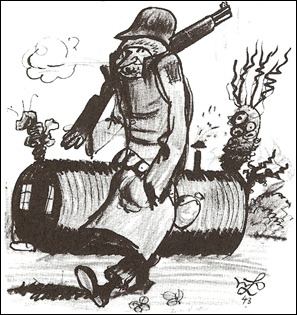 Trooper pulling guard duty outside a hut, Winter, 1943.
Trooper pulling guard duty outside a hut, Winter, 1943.
Sketch by William L. Prescott (AKA Linzee Prescott by the 505), 1943
Notice the All American (AA) 82nd Airborne unit insignia is sewn over with a plain cloth patch to hide the unit’s identity.
Source: “Saga of the All American” Dawson, Forrest W., 1946, unpaginated
Christmas 1943 in Northern Ireland
Part of the 82nd Division including the 508th PIR, 505th PIR, the 325th GIR and other smaller units (such as Divisional Headquarters Company, the 407th Airborne Quartermaster Co, 307th Airborne Medical Co, 82nd Airborne MPs, 82nd Airborne Signal Co, 782nd Airborne Ordnance Co, the 307th Airborne Engineers minus C Co), among others celebrated Christmas 1943 in Northern Ireland.
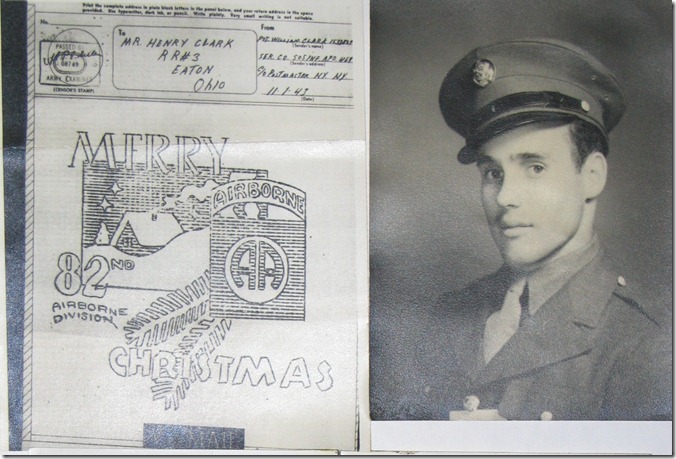 Christmas 1943 in Northern Ireland
Christmas 1943 in Northern Ireland
Source: Author’s Collection
Click on the image for higher resolution.
You’ll notice Bill’s Christmas card is postmarked November 1, 1943. Bill must have sent the card while performing occupation duty in Naples, Italy. At 55 days before Christmas, the date gives an idea of the estimated time it might have taken for the Christmas mail to arrive from the ETO to the US; which is surprising since this is Victory Mail (as indicated by the words “V MAIL” at the bottom of the card). V MAIL was sent by aircraft. It arrived much more quickly than regular mail which was sent by ship. The space for writing a message using V MAIL was very small in comparison to a letter which could be any number of pages. Many people didn’t like using V MAIL for this reason, but I think it suited Bill, since as the war progressed he wrote home less often. Bill’s brother, Henry Clark Jr., explained why in a letter dated December 23, 1944:
“I can understand why he [meaning Bill] doesn’t write. If I had been over here as long as he has I probably wouldn’t be writing but semi annually either. In other words the longer and further you get away from home the less one writes. I’m going to drop him a line tonight and see if I can get him “on the ball”. In other words I am going to mildly inform him that he has a few obligations as far as his correspondence is concerned….” Source: “Letter written home from Somewhere in France” Henry Clark Jr. December 23, 1944 p. 2
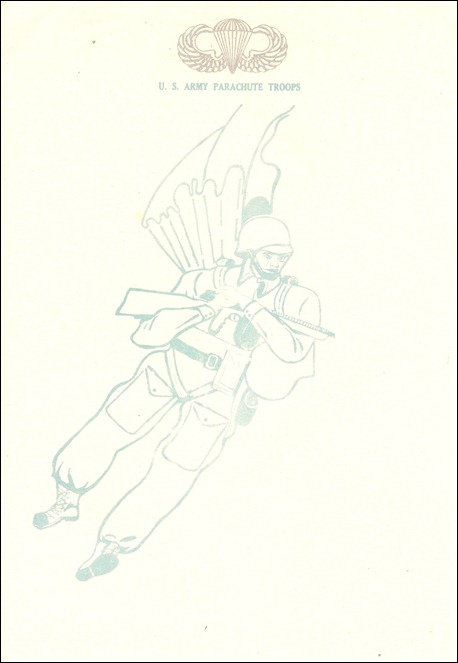 Bill’s unused Army Issue Airborne Stationary
Bill’s unused Army Issue Airborne Stationary
Source: Authors Collection
Bill’s unused Army Issue Airborne Stationary
Source: Authors Collection
Bill said he had memories of a special Christmas in 1943. In every town and village their was at least caroling. In the bigger towns, there were church services and even a dance at the American Red Cross Service Club in Portrush. Wherever the men of the 82nd were stationed in Northern Ireland, the people treated them with all the hospitality their war stricken rationing could muster. The soldiers were welcomed into the people’s homes by order of their own Prime Minister, but from reading some of the war memoirs of 82nd men and from what Bill told me, it is clear the locals would have done it anyway.
A significant number of 82nd men were of Irish descent and found they had distant and even near relatives living in the area. Other troopers had friends or associates from their home towns, whose family had immigrated to the US from Northern Ireland. In many cases, these people developed the foundations for what were to become life long relationships. Some men met Irish women, fell in love, and later married them. Other troopers would make the journey back to Northern Ireland many times in later years to stay connected with their war time friends. Such was the very special and lasting bond between the 82nd Airborne troopers and the people of Northern Ireland.
A Cold Winter
Bill never mentioned anything about how cold it was during his winter stay in Northern Ireland. But by all accounts it was absolutely frigid. For the 82nd men who fought in North Africa and Italy, the change in climate was dramatic. Not only was it cold, but it was damp. Most of the time it was overcast. For men stationed in the Quonset and Nissen huts, there was no insulation. They slept on hard wooden bunks without mattresses. Their only source of heat was a single small stove which they stoked with a meager daily ration of coal or peat. These stoves gave out little heat because they were insulated to keep their tin metal casings from melting. Many a trooper never forgot how cold they were in Northern Ireland. The following two sketches are by William L. Prescott a famed WWII artist and paratrooper assigned to 505 PIR Regimental HQ Company.
 505 PIR troopers suffering the cold in a Nissen hut at their Cookstown camp, Winter, 1943.
505 PIR troopers suffering the cold in a Nissen hut at their Cookstown camp, Winter, 1943.
Sketch by William L. Prescott. (AKA Linzee Prescott by the 505)
Source: “Saga of the All American” Dawson, Forrest W., 1946, unpaginated
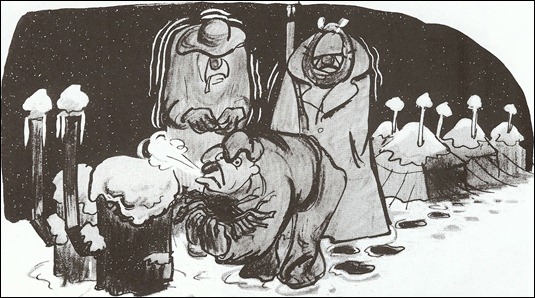 Well bundled troopers in winter issue shivering beside cold stoves in Northern Ireland, Winter, 1943.
Well bundled troopers in winter issue shivering beside cold stoves in Northern Ireland, Winter, 1943.
Sketch by William L. Prescott. (AKA Linzee Prescott by the 505)
Source: “Saga of the All American” Dawson, Forrest W., 1946, unpaginated
The Republic of Northern Ireland
One other thing Bill talked about was the Republic of Ireland. He said:
“The troops were not allowed to go to Dublin because that was in a different country.” Source: Interview with William Clark by Herd Bennett, January 26, 2000
Without going into a discussion of politics, Northern Ireland is part of the UK with its own legislative government. It borders the Republic of Ireland of which Dublin is the capitol city. The Republic of Ireland was a neural country in WWII. While some 82nd soldiers stationed in Northern Ireland may have visited “free Ireland” as they called it, Bill never did. It would have meant a court marital; possibly with a sentence in a Stateside Federal prison. During WWII, blackout conditions were in force all across Northern Ireland. Indeed Belfast had been the target of German bombing raids during the time known as the “Belfast Blitz”. The sun set early and rose late. Most of the time it was dark with overcast days. Some 82nd men were stationed close enough to the border with the Republic of Ireland to see some of its cities lights at night. In the blackout conditions which made the long nights seem interminable, the lights of “free Ireland” must have been a significant temptation for them.
Reluctantly Moving On
Despite the dark, cold, damp and cloudy conditions, Northern Ireland will always be a special place for the veteran men of the 505 PIR, the 325 GIR, and many smaller veteran attached or organic 82nd units. All these units combated not only the formidable Axis powers in the Mediterranean, but the harsh climate in North Africa, and the depressing privations endured during their time there.
The 505 riggers left Ballymoney on February 14, 1944. Their hearts were heavy. In light of what they had experienced, Northern Ireland had been too good to be true – and as time went on – too good to last. In Bill’s mind, it was incomprehensible how any civilized country could function so well being that close to Nazi occupied Europe, with Luftwaffe bombing raids, and the U-boat threat to shipping. Bill was soon to discover that their new destination of England was to prove equally welcoming, and its ability to function in spite of the long war, just as incomprehensible.
Unlike the 82nd’s time in Northern Ireland, their time in England would be accompanied by a most intensive training program. They were to be thrown into the thick of the invasion preparations. In a short time, a sense of foreboding was to grow among the men; with the outcome being very uncertain. As I’ll make more clear over the next few posts, it is becoming evident that Bill often had the choice of relatively safe missions or dangerous ones. As often as he could, he was to choose danger. In his eyes the Normandy invasion presented an opportunity which he was unwilling to resist.
© Copyright Jeffrey Clark 2012 All Rights Reserved.

